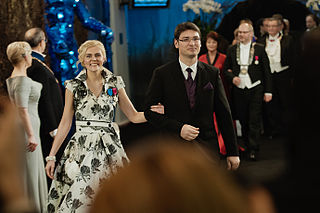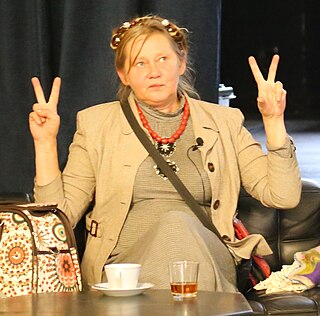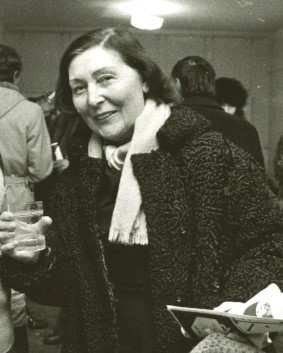Related Research Articles

Jõgeva is a small town in Estonia with a population of around 5000 people. It is the capital of Jõgeva Parish and Jõgeva County.

Alavere is a village in Anija Parish, Harju County in northern Estonia. The population was 345 in 2019.
Eduard Wiiralt was a well-known Estonian graphic artist. In art history, Wiiralt is considered as the most remarkable master of Estonian graphic art in the first half of his century. The best-known of his works include "Inferno", "Hell", "Cabaret", "Heads of Negroes", "Sleeping Tiger", and "Head of a Camel".

Julia Laffranque, is an Estonian jurist, judge, legal scientist, visiting professor of European law Justice at the Supreme Court of Estonia, Judge at the European Court of Human Rights 2011 - 2020. Since 4 June 2018 also a member of the Scientific Committee of the European Union Fundamental Rights Agency, earlier professor of European law at the University of Tartu. Since 2020 member of the Board of Trustees, the Foundation Academy of European Law Trier. In 2019 she was a candidate for the post of European Ombudsman. In 2020 she was appointed as Director of Programme of the European Law Academy (ERA) and in 2021 the Council of the European Union on the proposal of European Parliament by 586 votes in favor, appointed her as a member of Article 255 TFEU panel, which is to give opinion on candidates suitability to perform the duties of judge and advocate general of the Court of Justice and the General Court of the European Union.

Eduard Vilde was an Estonian writer, a pioneer of critical realism in Estonian literature, and a diplomat. He was the author of classics such as The War in Mahtra and The Milkman from Mäeküla. He was one of the most revered figures in Estonian literature and is generally credited as being the country's first professional writer.

Sangaste is a small borough in Otepää Parish, Valga County, southern Estonia. Sangaste has a population of 228.

Roosna-Alliku is a small borough in Paide municipality, Järva County in northern-central Estonia. Prior to the 2017 administrative reform in Estonia of local governments, it was the administrative centre of Roosna-Alliku Parish.

Muuga is a village in Vinni Parish, Lääne-Viru County, in northeastern Estonia. Between 1992 and 2017 the village was located in Laekvere Parish.

Alatskivi Castle is a Neo-Gothic castle in Alatskivi, Estonia. Dating to the 17th century, it is situated in Peipsiääre Parish, Tartu County. It was rebuilt in the late 19th century by Baron Arved von Nolcken, modeled on the royal residence of Balmoral in Scotland. A renovation occurred between 2005 and 2011. Five rooms on the first floor house the Eduard Tubin museum, which documents his accomplishments as a music composer and conductor.
Ellen Alaküla was an Estonian stage, radio, television, and film actress and theatre teacher whose career spanned over forty years.
Liina Olmaru is an Estonian stage, radio, television, and film actress.
Eili Sild is an Estonian stage, film, television and radio actress whose career began on the theatre stage in the early 1960s and has spanned over fifty years.

Merle Jääger is an Estonian television, stage and film actress, poet and author who frequently uses the pen name Merca. Initially associated with the burgeoning Estonian punk rock scene of the early to mid 1980s, she has been described as the "bard of protest". Her career as an actress began in her early 20s and she has received a number of high-profile awards for stage roles.
Paul Poom is a former Estonian stage, film, television, and radio actor whose career began in the late 1970s and ended in 1993 after an assault left him permanently disabled.
Vello (Ergav-Vello) Asi was an Estonian interior architect, graphic designer and professor at the Estonian Academy of Arts. Together with Väino Tamm, he has been one of the most important interior architects and representer of modernist interiors in Estonia since the late 1950s.
Ülo Õun was an Estonian sculptor whose career began in the late 1960s and came to prominence in the 1970s. Õun mainly worked as a portrait and figural sculptor and was known for his works in colored plaster and bronze.

Maarja Jakobson is an Estonian television, stage and film actress whose career began in the late 1990s.
Jüri Tuulik was an Estonian writer and playwright.

The Tartu Credit Center Massacre was the mass murder of 19 people in the basement of the former Credit Center in Tartu on 14 January 1919.

Helmi Üprus was an Estonian architectural and art historian. She trained in romance languages, studied English and ethnography, and earned a master's degree in art history from the University of Tartu in 1936. She worked her way up to head the cultural history department of the Estonian National Museum, where she researched folk art. In 1947, she began working at the Institute of History of the Academy of Sciences of the Estonian SSR. Persecuted by Stalinism she lost her job in 1950 and worked in a factory until Stalin's death. From 1953, she was the chief specialist in architecture and history for the government monument restoration service.
References
- ↑ Twentieth-Century Eastern European Writers: Second series, Volume 2. Detroit: Steven Serafin. 2000. p. 310.
- ↑ Hasselblatt, Cornelius (2008). Geschichte der estnischen Literatur: von den Anfängen bis zur Gegenwart. Berlin: De Gruyter. p. 336.
- ↑ "Eduard Vilde". Estonian Writers' Online Dictionary. Tartu: University of Tartu Department of Literature and Theater Studies. Retrieved November 11, 2023.
- ↑ Tuglas, Friedebert (1959). Teosed: Valik kriitilisi tõid. Tallinn: Eesti Riiklik Kirjastus. p. 253.
- ↑ Mihkla, Karl (1972). Eduard Vilde, elu ja looming. Tallinn: Eesti Raamat. p. 103.